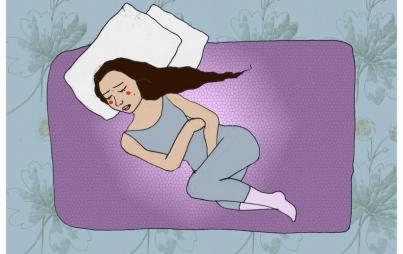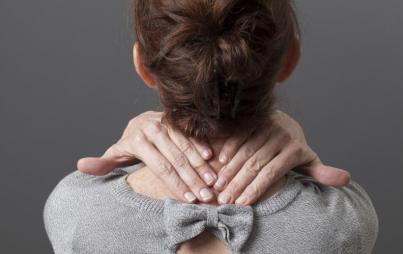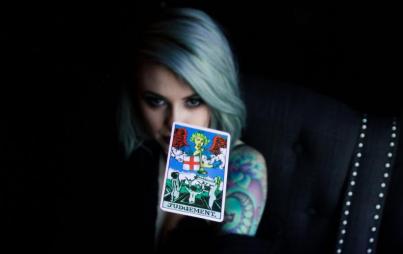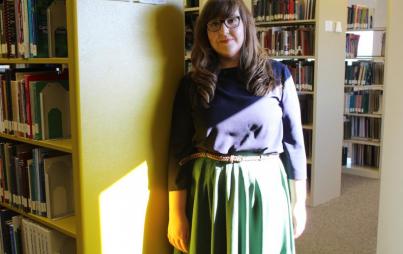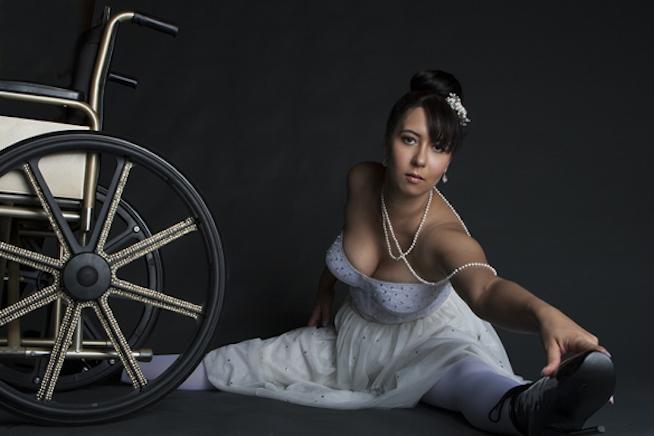
When Caitlin Myers performs burlesque as part of this week's Body Love Conference in Tucson, it will be in her new wheelchair - a gold painted, sequined wheelchair she has transformed into her own throne. Caitlin sat down with friend and fellow burlesque performer Adiba Nelson to reveal why her wheelchair has become her seat of power, and made her love her body even more. Photos by Danni Valdez. Hair and make-up by Perfection Artistry. Jewelry by Christine Bartfai. Photography assistant: Jocelyn Warner-Brokamp.
**Editor's note: The Body Love Conference is a "progressive, positive, high-energy event where participants can celebrate and inspire each other and themselves to change the world, and love their bodies." It was held in Tucson, Arizona on June 6, 2015. For more information, please visit their website.
 When I was asked to interview Caitlin for this story, I was excited and angst ridden at the same time. I met Caitlin in November 2014 as we both navigated our way through burlesque. I was excited to sit down with my gal pal and chat our faces off over mimosas. I was also terrified because I knew Caitlin had a story, and I didn’t want to get it wrong. Much like my own daughter, Caitlin has a disability and, much like my daughter’s disability, hers is incredibly rare. But also, much like my daughter, Caitlin Rose Myers is a force to be reckoned with.
When I was asked to interview Caitlin for this story, I was excited and angst ridden at the same time. I met Caitlin in November 2014 as we both navigated our way through burlesque. I was excited to sit down with my gal pal and chat our faces off over mimosas. I was also terrified because I knew Caitlin had a story, and I didn’t want to get it wrong. Much like my own daughter, Caitlin has a disability and, much like my daughter’s disability, hers is incredibly rare. But also, much like my daughter, Caitlin Rose Myers is a force to be reckoned with.
She has struggled with what she now knows is Ehlers-Danlos Syndrome for nearly her entire life (she was only recently diagnosed). It is a connective tissue disorder that causes chronic pain. She has been told numerous times by numerous doctors that she should not dance. However, Caitlin pushed through. She craved dance, she needed it, and has stopped at nothing to get it. Caitlin is the only burlesque performer in Tucson who uses her wheelchair in her acts. Through her performances she is challenging the social norm that says a disabled body is not a beautiful body. She is tearing down walls of limitations for people who once thought doors were closed to them, simply by saying “find a way, any way, to be authentically YOU”.

Caitlin, anyone who has ever seen you on stage knows that you are an incredible performer. You move like it’s as natural as breathing. How did you get started in dance? Is it an inherited talent, or are you one of those people God just touched with the ballet stick and said “Poof! You shall be a dancer!” "My mother was a dancer and she imparted that love of dance to me. I took ballet, tap and jazz from four or five years old. Every single week I was in somebody’s class dancing. I just loved moving. It became my passion. For some reason at that time my favorites were tap and jazz, but not ballet. Even at that young age I could tell that I wasn’t the ‘normal’ ballerina shape."
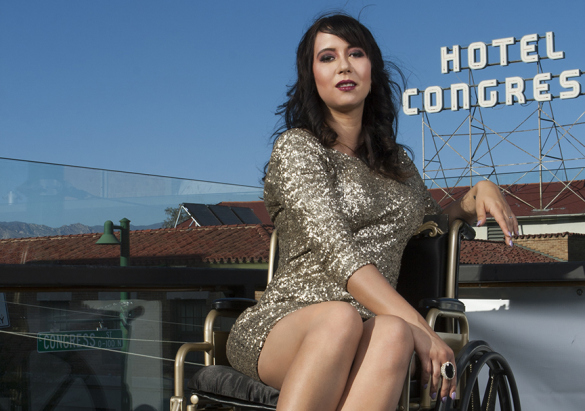
The ‘normal’ ballerina shape. Oh, you mean petite, slender, and not chesty in the slightest?" Yes. I was always tall, and tall women don’t make good ballerinas. Neither do chesty girls, which I was. And I had a larger bum than all the other girls. So, there were a lot of reasons. I remember we had a ballet teacher and she was very traditional – complete with a heavy cane that she would rap on the floor. She was always coming around and gently tapping me with the cane on my lower back and saying “BUTT IN! BUTT IN!”, and I was like “My butt is in as much as it can be! I just have a big butt - it doesn’t go anywhere!” So needless to say, ballet was not my favorite."
Completely understandable! I don’t think I would love it either. Actually, I didn’t love it for those very reasons – I was also always the big girl in the class. However, you continued dancing. Did you continue with ballet? So much of modern dance and jazz is gleaned from ballet. "No, I loved tap and jazz. I loved how fun it was and how free it was, but around the time that little girls in ballet transfer into pointe, what we now know was Ehlers-Danlos Syndrome began to rear its head. I started to complain about leg pain when they tried to make me do a lot of pointe work. After seeing a doctor it was decided that it probably wasn’t a good idea that I go into pointe.
"But I still kept dancing – I just found new ways to dance. I kept doing tap and jazz and added in swing dancing. And then I got into Indian classical dance. But again, that is a style of dance that is very hard on your knees due to the standard position, so that didn’t last long. But I had this passion – I had to perform. So I came back to belly dance, and actually got to a point where I was teaching classes. I did that for a year and a half. And then everything changed.
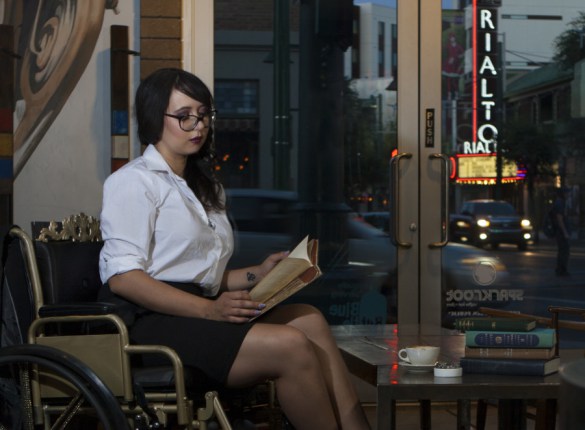
"I was teaching a move called the Turkish Drop. From standing you drop directly down, with your knees thrust forward and your back down on the floor. I was practicing those and I went down and then I could not get up. I was laying and I remember thinking ‘this hurts too much - more than it should’. It was really scary. Coincidentally, this was also when I was starting to do burlesque for the first time. In my act I was a maid balancing a tea set on my head, and I went down into a slow Turkish Drop. It was right after that when I realized the pain wasn’t going anywhere."
And then you were hit by a car. First of all, I can’t even begin to imagine the pain simply from being hit, but you were already in immense pain from the Ehlers-Danlos Syndrome. I know from our conversations that this accident marked the first time you ever had to use a wheelchair. How did this affect you? "It was very intense. I have a lot of memories of butt-scooting down the stairs of my apartment just so I could see the sunlight outside. I had to heal mentally and physically. I didn’t dance for a long time because of the mental anguish and the ridiculously long healing process.
"In hindsight, I realize that Ehlers-Danlos Syndrome has been behind my lack of healing the entire time. When the physical therapy wasn’t working, when the doctor recommended surgery to release the tension on my patella and it didn’t work, when nothing I did was helping me heal, it was due to the Ehlers-Danlos Syndrome. I didn’t finally get a diagnosis until this year, when my husband’s doctor looked at my records and said 'This is not normal – someone this young should not be in this much pain every single day.' To finally hear that, that validation – it was amazing."
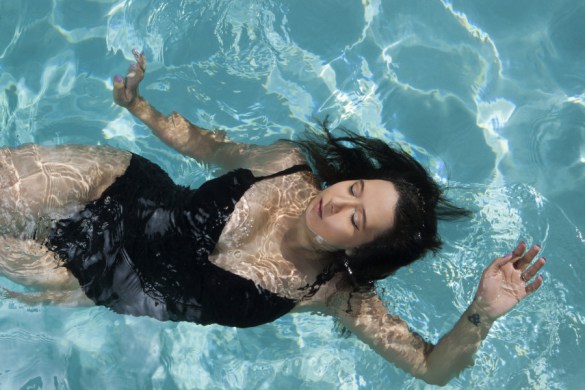 I remember that. By that point you and I were already in Burlesque for the Soul together. But your doctors had told you that you really shouldn’t dance anymore, and the pain wasn’t going away. So how did you get to that point in your head where you were just like “f you - I’m gonna do what I wanna do? I’m gonna push through this and do this program.” What happened? " I needed power. I remembered when I first got into burlesque in college, it was after a particularly horrible break-up and I needed power, and some sort of self-affirmation that I was worth more than my ex said I was. When I met the women of that troupe in college I noticed how powerful and strong they were. Their acts were almost like a joyfully antagonistic reclaiming of their sexuality, as if to say 'This is mine, and I’m gonna use it the way I want to, not the way you tell me to'. I also attended a workshop with world-renowned burlesque performer Rose Wood and I’ll never forget her words: 'Challenge the notion that when people go to a burlesque show they’re there to be seduced. I am not on stage to be what they want me to be, I’m there to be what I need to be.' Those words stuck with me."
I remember that. By that point you and I were already in Burlesque for the Soul together. But your doctors had told you that you really shouldn’t dance anymore, and the pain wasn’t going away. So how did you get to that point in your head where you were just like “f you - I’m gonna do what I wanna do? I’m gonna push through this and do this program.” What happened? " I needed power. I remembered when I first got into burlesque in college, it was after a particularly horrible break-up and I needed power, and some sort of self-affirmation that I was worth more than my ex said I was. When I met the women of that troupe in college I noticed how powerful and strong they were. Their acts were almost like a joyfully antagonistic reclaiming of their sexuality, as if to say 'This is mine, and I’m gonna use it the way I want to, not the way you tell me to'. I also attended a workshop with world-renowned burlesque performer Rose Wood and I’ll never forget her words: 'Challenge the notion that when people go to a burlesque show they’re there to be seduced. I am not on stage to be what they want me to be, I’m there to be what I need to be.' Those words stuck with me."
That is such a strong statement, and it is exactly what you’re doing now with burlesque. Watching you go through the process from beginning to end, just even signing up for Burlesque For The Soul, was the beginning of reclaiming your power. "It is a strong statement, but it is everything that I think burlesque is. It was that statement and a huge leap of faith that pulled my act together. When it came time to actually conceptualize the act, I knew I had to use a chair but I wanted it to be a “happy” chair – a chair that made a statement. Well, what’s a happy chair? A throne. And that song Royals by Lorde was still popular, so it just fit. I would perform in a throne.
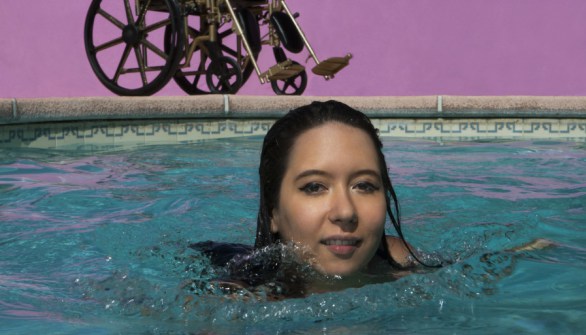 "But then the idea of using the wheelchair was brought up, and I fought against it. The very notion of it harkened back to a time when I was confined to my apartment, trapped in a wheelchair and in immense pain due to that stupid car accident. I wanted nothing to do with it. But then you and the ladies of Black Cherry Burlesque reframed it for me, and helped me see that a wheelchair could actually be a very powerful tool – giving me greater freedom and independence in my movement.
"But then the idea of using the wheelchair was brought up, and I fought against it. The very notion of it harkened back to a time when I was confined to my apartment, trapped in a wheelchair and in immense pain due to that stupid car accident. I wanted nothing to do with it. But then you and the ladies of Black Cherry Burlesque reframed it for me, and helped me see that a wheelchair could actually be a very powerful tool – giving me greater freedom and independence in my movement.
"Once I realized that, the love affair began. I now had my seat of power, my throne, if you will. That’s why I customized my chair to look like a throne. And that’s why I liked it in my act: because I was truly in love with it and all that it represented for me. It was no longer a trap or a cage. It was freedom. It was power. It was sexy. And it was mine. Every time I worked on it I got happier and happier. When I finally finished spray painting it [metallic gold], applying gold sequins to the spokes, and adding a back with a gold wood detail, I pushed it out into the sun to take a picture and was just in awe of it. It was beautiful, and that moment marked the turning point in accepting what was happening to my body."
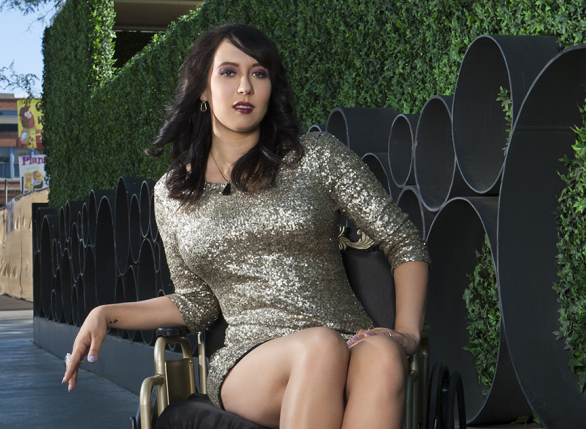
Did you have any idea how powerful that moment would be (in your act) when you got up into your wheelchair? How did that moment feel? Because I can tell you that watching it – it was a HUGE moment. Immensely powerful. "I knew that it was a powerful moment. I knew that sitting in a wheelchair and putting a crown on my head was important in a broader sense. We had the dress rehearsal and [burlesque performer] Paco Fish filmed it. There’s something that I see when I watch that first rehearsal. There’s an aggressive power in my movements. I watch it now and realize that was the moment. It was kind of a ‘f you’ moment. At that moment, all of my fears of went away. I put that crown on my head and was like 'I don’t care if this is not what you paid for, this is me. This is what I wanna do, so deal with it'. The entire struggle to accept this part of my life was gone. I didn’t even have the diagnosis yet. I just knew that I was going to be the kind of performer I needed and wanted to be."
Which leads me to your *new* stage name. You were previously known as Jacqueline Boxx, now you've added. Miss Disa-Burly-TEASE. Tell us about that. "One of the reasons I love that name so much is because of the playfulness of it. The 'tease' in all caps challenges the notion that if you have a disability you can’t be cute, playful and sexy. And I wanted to say that yes, you absolutely can be. That’s how a lot of non-disabled people develop their burlesque personas - cute, playful, sexy. In a way I’m combining the general aesthetic with the social consciousness work that I want to do - in terms of letting my story of my body be told and heard."
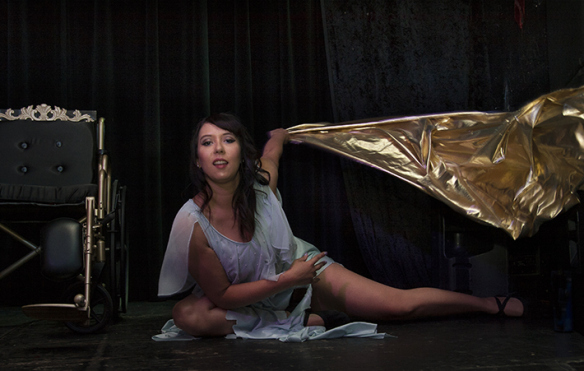
I wonder if for some people it borders on fetishization, the notion of disabled and sexy? "You hit the nail on the head. There is a perceived fetishization that comes along with finding someone with a disability attractive or sexy, and I want to challenge that. Why can’t someone in a wheelchair be sexy? Why can’t they be hot? My first act was very sensual - I mean for Pete’s sake I licked my wheelchair as I was groping it. I want to have more people question against the norm. They’re recoiling against the idea of someone being sexy and in a wheelchair. People in wheelchairs have sex! It happens! And you don’t have to be a freak to be attracted to them. You can be a freak if you want to be a freak, but it has nothing to do with the wheelchair. People with disabilities have sex too, and it doesn’t make you weird, strange or bad if you lust after them. It makes you human."
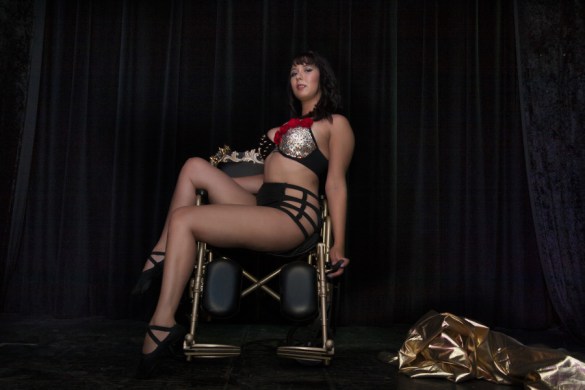
You are a powerhouse - wheelchair, crutches, leg brace, whatever - you are incredible. Your message is fierce, and as real and raw as one would expect of a woman strives to live authentically. So what’s next for you? What sort of shimmies and shakes do you have coming down the pipeline? "With Ehlers-Danlos you never know. It’s not something that gets better. There’s no cure, only pain management and ongoing physical therapy, and sometimes even that is difficult. But for now I’m still shimmying, so I will shimmy until I can shimmy no more! I think it would be great to teach workshops someday, to other individuals with disabilities who maybe thought that burlesque wasn’t available to them. I’d like to guide them in telling their own story through burlesque, because honestly, if all you can do is just move my shoulder, I can do burlesque."
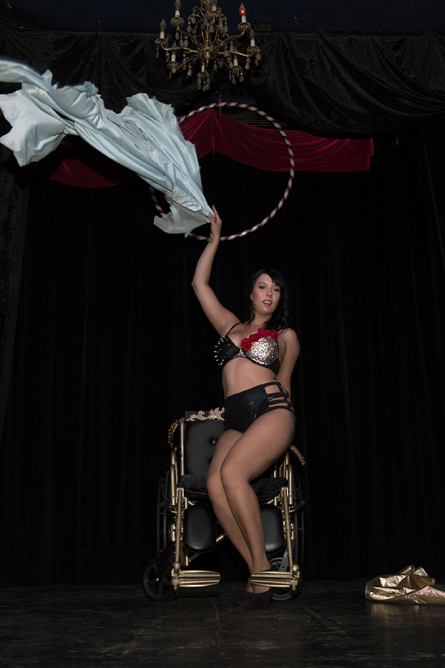 I am incredibly excited, thrilled and so honored to be sharing the stage with you this week. I feel like every time I watch you perform I learn something new, a different nerve in me is struck, another ‘a-ha’ moment takes place. The dash of your life - you know, the dash between the date of your birth and the date of your death - that dash is going to be so full of “How did she do that?” and “Oh my goodness, this woman!”. But I have to know, what do you want the dash of your life to be chockfull of? "I want it to be full of 'She lived authentically. She was true to herself, and in that, she encouraged other people to be true tothemselves and live authentically.' Everything I’ve experienced, good and bad, has made me who I am right now - - and there’s been a lot of bad. My diagnosis comes with hyperflexibility and I am now incredibly flexible in my life. I can just go with the flow. I don’t have to hold on to the structure of what once was. I am now just able to say 'This is how it is'. Ehlers-Danlos Syndrome almost took center stage in my life but I’m a performer, and when I’m on stage I’m performing on my terms, disabled or not. And my light’s not out yet, so the show must go on.
I am incredibly excited, thrilled and so honored to be sharing the stage with you this week. I feel like every time I watch you perform I learn something new, a different nerve in me is struck, another ‘a-ha’ moment takes place. The dash of your life - you know, the dash between the date of your birth and the date of your death - that dash is going to be so full of “How did she do that?” and “Oh my goodness, this woman!”. But I have to know, what do you want the dash of your life to be chockfull of? "I want it to be full of 'She lived authentically. She was true to herself, and in that, she encouraged other people to be true tothemselves and live authentically.' Everything I’ve experienced, good and bad, has made me who I am right now - - and there’s been a lot of bad. My diagnosis comes with hyperflexibility and I am now incredibly flexible in my life. I can just go with the flow. I don’t have to hold on to the structure of what once was. I am now just able to say 'This is how it is'. Ehlers-Danlos Syndrome almost took center stage in my life but I’m a performer, and when I’m on stage I’m performing on my terms, disabled or not. And my light’s not out yet, so the show must go on.
*This article first appeared in 3storymagazine.com. Read more of Adiba Nelson on her blog The Full Nelson and in The Huffington Post.



